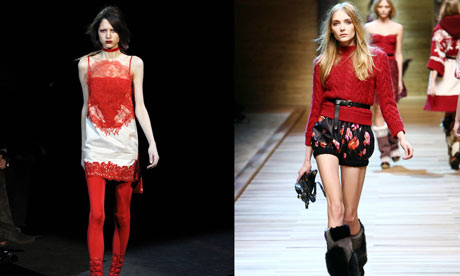
Riccardo Tisci and Dolce and Gabbana models at this year's shows
Hayley Morley, a size 12, took to the catwalk for knitwear designer Mark Fast. Lizzie Miller, a size 14, caused a furore when pictured naked with a roll of stomach flesh in US Glamour magazine. And then there was the size 16 supermodel, Crystal Renn, who published her autobiography Hungry, and appeared in Vogue, Glamour and V magazine's Size Issue. Renn said that a new kind of model was emerging, "lush and sparkly with nary a jutting collarbone in sight".
Then came the latest round of autumn/winter ready-to-wear shows, which ended in Paris last week. Jutting collarbones weren't just easy to spot; they were almost ubiquitous. There were the hollowed-out necks striped with taut, rope-like tendons, straining to keep balloon-like heads aloft on childlike shoulders. There were the tiny upper arms, fragile and snappable as a bird wing stripped of feathers. And, perhaps most notably, there were the women's thighs, space gaping between them, often even slimmer at their upper reaches than at the stark, bony knees. In some cases, it was hard to fathom how the women could walk. There were a couple of shows – Louis Vuitton and Prada – where healthier bodies were on display. But they were the exceptions; and anyway they weren't a political statement, they were simply an aesthetic choice. Miucca Prada did put healthy women into that Prada show, but at her other show – her Miu Miu show – some of the models were skeletal.
Even designer from whom you might expect more, such as Stella McCartney – famous for designing trousers that real women can actually wear – put models on the catwalk who looked far too thin for comfort.
No one seems to have said a thing. After years of arguments about the extreme thinness of fashion models, after horror at the 2006 deaths of Luisel Ramos (who had fasted for several days), and Ana Carolina Reston (who died from an infection related to anorexia), after the editor of British Vogue, Alexandra Shulman, voiced her worries last year about models with "jutting bones and no breasts or hips", the debate seems to have gone eerily silent.
It's not clear why. Perhaps it's that the existence of a few healthier women has acted as a diversion, has convinced the outside world that the industry is changing. Or perhaps it's just that we're tired of talking about it. After all, emaciated women have been a fixture in fashion for at least 15 years now, since the amazonian supermodels of the late 80s and early 90s – Cindy Crawford, Linda Evangelista, Naomi Campbell, Christy Turlington – made way for heroin chic and hollowed-out eyes, for an ideal of womanhood that has become thinner and thinner and thinner.
But it does seem important to point out that this is still going on, that the images of women that are multiplying around us look not just unhealthy, but in some cases horrifying. It's not that every woman on the catwalk has to be a certain size, not that they all need to be weighed at the door to the venue, but it would be a big leap forward if catwalk photographs didn't seem bound, instantly, for a pro-anorexia website. Surely that's not too much to ask?

No comments:
Post a Comment